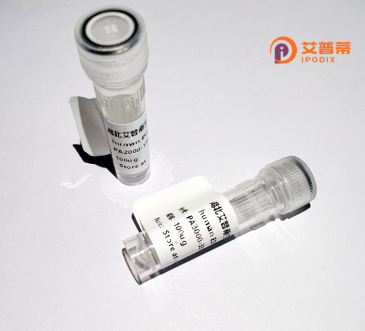
| 纯度 | >90%SDS-PAGE. |
| 种属 | Human |
| 靶点 | ROM1 |
| Uniprot No | Q03395 |
| 内毒素 | < 0.01EU/μg |
| 表达宿主 | E.coli |
| 表达区间 | 1-351aa |
| 氨基酸序列 | MAPVLPLVLPLQPRIRLAQGLWLLSWLLALAGGVILLCSGHLLVQLRHLGTFLAPSCQFPVLPQAALAAGAVALGTGLVGVGASRASLNAALYPPWRGVLGPLLVAGTAGGGGLLVVGLGLALALPGSLDEALEEGLVTALAHYKDTEVPGHCQAKRLVDELQLRYHCCGRHGYKDWFGVQWVSSRYLDPGDRDVADRIQSNVEGLYLTDGVPFSCCNPHSPRPCLQNRLSDSYAHPLFDPRQPNQNLWAQGCHEVLLEHLQDLAGTLGSMLAVTFLLQALVLLGLRYLQTALEGLGGVIDAGGETQGYLFPSGLKDMLKTAWLQGGVACRPAPEEAPPGEAPPKEDLSEA |
| 预测分子量 | 37,2 kDa |
| 蛋白标签 | His tag N-Terminus |
| 缓冲液 | PBS, pH7.4, containing 0.01% SKL, 1mM DTT, 5% Trehalose and Proclin300. |
| 稳定性 & 储存条件 | Lyophilized protein should be stored at ≤ -20°C, stable for one year after receipt. Reconstituted protein solution can be stored at 2-8°C for 2-7 days. Aliquots of reconstituted samples are stable at ≤ -20°C for 3 months. |
| 复溶 | Always centrifuge tubes before opening.Do not mix by vortex or pipetting. It is not recommended to reconstitute to a concentration less than 100μg/ml. Dissolve the lyophilized protein in distilled water. Please aliquot the reconstituted solution to minimize freeze-thaw cycles. |
1. **"Cloning and characterization of ROM1. a human retinal outer segment membrane protein"**
*Bascom RA, et al.*
该研究首次克隆了人类ROM1基因,并解析其编码的视网膜外节膜蛋白结构,探讨其在光感受器细胞中的功能及与周边蛋白的相互作用。
2. **"Mutations in the ROM1 gene associated with retinitis pigmentosa"**
*Dryja TP, et al.*
文章通过分析视网膜色素变性患者样本,发现ROM1基因突变可导致光感受器细胞结构异常,揭示了ROM1在维持视网膜外节完整性中的关键作用。
3. **"Interaction of ROM1 with peripherin/rds in photoreceptor outer segment membranes"**
*Kajiwara K, et al.*
研究利用重组ROM1蛋白与周边蛋白(peripherin/rds)进行体外结合实验,证实两者形成异源四聚体复合物,对光感受器盘膜结构的组装至关重要。
4. **"Structural analysis of ROM1 in rod photoreceptor cells using recombinant expression"**
*Goldberg AF, et al.*
通过重组表达技术解析ROM1蛋白的跨膜结构域及C末端相互作用位点,阐明了其在光信号传导和视网膜退行性疾病中的潜在机制。
ROM1 (Retinal Outer Segment Membrane Protein 1) is a critical protein involved in the structural organization and stability of photoreceptor cells in the retina. It belongs to the tetraspanin family of membrane proteins, characterized by four transmembrane domains. ROM1 is predominantly expressed in the rod photoreceptors of the retina, where it interacts with peripherin/RDS (Retinal Degeneration Slow) to form heterotetrameric complexes. These complexes are essential for the formation and maintenance of the highly organized disc membranes within the outer segments of photoreceptors, which are crucial for phototransduction.
Discovered in the early 1990s, ROM1 gained attention due to its role in inherited retinal diseases. Mutations in the ROM1 gene are associated with autosomal dominant retinitis pigmentosa (RP) and other retinal dystrophies, often in combination with peripherin/RDS mutations. Unlike peripherin/RDS, ROM1 alone cannot cause disease but acts as a genetic modifier, influencing the severity and progression of retinal degeneration in compound heterozygous cases.
Recombinant ROM1 protein is produced using biotechnological platforms like bacterial or mammalian expression systems. This allows researchers to study its biochemical properties, interaction networks, and pathogenic mechanisms. Recombinant ROM1 has been instrumental in structural studies, including cryo-EM and X-ray crystallography, revealing how ROM1-RDS complexes stabilize disc rim architecture. It also serves as a tool for developing gene therapies and pharmacological interventions targeting ROM1-associated retinal disorders. Current research focuses on leveraging recombinant ROM1 to model disease pathways and test CRISPR-based or small-molecule therapies for inherited blindness.
×